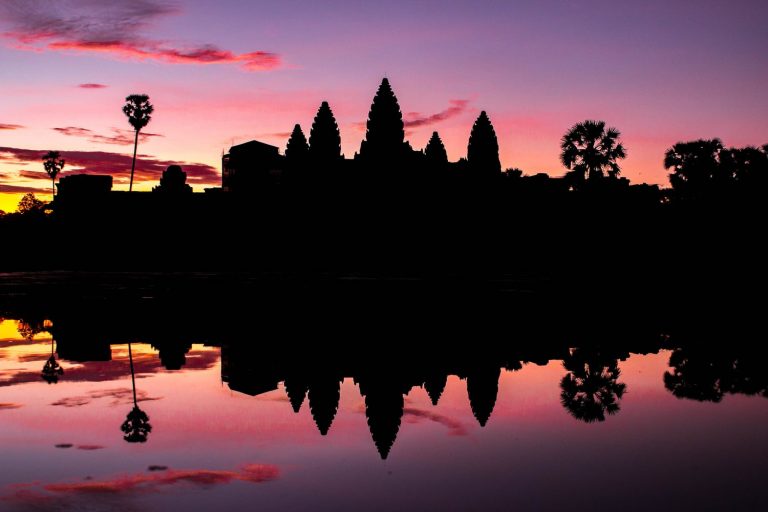
[ad_1]

While Angkor Wat is today filled with Buddha sculptures and other Theravada symbols, this was not initially the case. Built during the reign of the Khmer King Suryavarman II in the 12th century, the original decorations depicted Hindu deities and stories. Over the ensuing years, the influence and acceptance of Buddhism grew in the Khmer Empire. One theory holds that Khmer leaders blamed a devastating defeat at the hands of the neighboring Cham people on the Hindu gods’ inability to protect them, and this may have encouraged the transition to a new dominant religion. In any case, Angkor Wat was eventually transformed into a Buddhist shrine.
When I walked out of the temple’s outer wall and headed back toward the bridge a few minutes before 9 a.m., I was greeted by a startling sight: A wave of humanity stretching from the parking lot onto the bridge rolled toward the site I was just exiting. Relieved to be escaping the crowds and the steadily increasing heat, I went in search of breakfast.
After eating, I visited the less-packed and more-shaded Ta Prohm temple. Of “Lara Croft: Tomb Raider” fame, its twisted passageways and hearty trees (many growing out of stone rubble) kept me happily occupied for another hour. By 12:30 p.m., I was worn out and ready to trade ancient civilizations for a more modern one. After another tuk-tuk ride, this time a bit longer because of traffic, I was back at my hotel.
No escape
Siem Reap has an excellent food scene. In addition to the aforementioned Italian restaurant and many great Khmer places, it is also home to my favorite Mexican joint in Southeast Asia. Needless to say, I spent my evenings after returning from the temples zipping around town from one eatery to the next. All of this back and forth gave me a good opportunity to observe the large crowds of Cambodian revelers enjoying the New Year festivities. None of them were dangerous, but almost all of them were armed with various forms of aqua artillery.
Roving bands of teenagers patrolled the streets, sometimes engaging other groups in spontaneous battles much larger than the skirmish I had observed a couple of nights before. Some groups rolled by in the back of large pickup trucks, the vehicles often pausing long enough for the occupants to spray pedestrians on the sidewalk before making a getaway. As I sped by in the back of the tuk-tuk, some took potshots at me. The few volleys that hit their mark provided a refreshing countervail to the blistering heat.
Later, during one of the few times that I was exploring the town afoot, I was spotted by a large Cambodian man. His face breaking into a wide smile, he started walking toward me. On his hands was a large amount of sticky white powder, another common munition in the New Year wars. People throw or smear mixtures of baby powder or flour and water on friends and, as in this case, complete strangers. “No, thank you!” I said politely as I tried to evade his grasp. He just smiled even wider and patted my cheeks, leaving behind a gooey, white paste. I had no problem with being sprayed with a water gun, but this was aggravating. I (mostly) maintained my composure and was able to clean myself up in the bathroom of the French bakery I had been walking to.
Interestingly, Cambodian authorities are discouraging these water and powder battles this year. According to the Phnom Penh Post, a letter from the minister of education, youth and sport characterized these activities as “disorderly, undignified and unsafe.” Instead, the country’s youth are being encouraged to participate in traditional Khmer games and dances. Whether such directives will be heeded remains to be seen. It does seem that drenching others is a relatively recent addition to Khmer New Year celebrations compared with other traditions. Sivleng Chhor, librarian at the Khmer Studies Center in Siem Reap, was not able to pinpoint the origins of these antics but said there was “no such game in (her) hometown” during her childhood. She was first introduced to the water wars later, after coming to Siem Reap. Water fights are also a part of the New Year in neighboring countries.
Religion, heritage and fun
For Cambodians, Khmer New Year is a time to fulfill religious obligations, celebrate their country’s rich history and enjoy fellowship with family and friends. From my conversations with Cambodian friends, it is clear that this is one of their favorite times of the year. Their pride in their culture is endearingly evident.
For this year’s holiday, which began April 14, the celebration in Siem Reap may have been even bigger than what I witnessed in 2022. After a hiatus of several years, the government approved organized events at Angkor Wat and other historic temples to showcase various aspects of Khmer culture. Called “Angkor Sankranta,” the gatherings are expected to bring even more people to Siem Reap.
While I’m not sad to be avoiding those massive crowds, I will miss seeing the joy on the faces of Cambodians of all ages. As an outsider, there are few better ways to see the spirit of a different culture than witnessing its celebrations. I hope that I’ll make it back to Siem Reap for another Khmer New Year one day. Whenever that happens, I’m going to bring the biggest water blaster they’ve ever seen.
[ad_2]
Source link